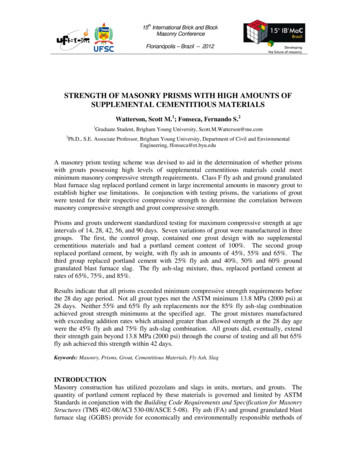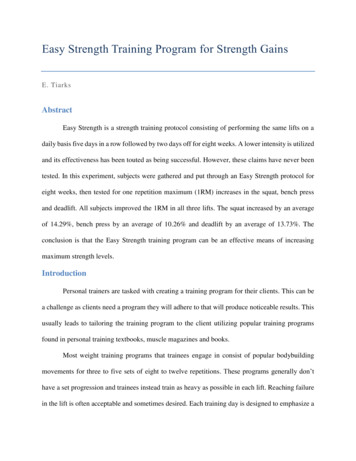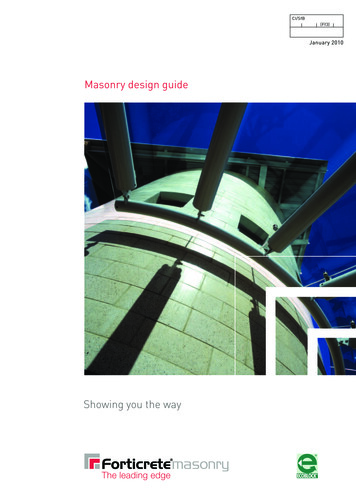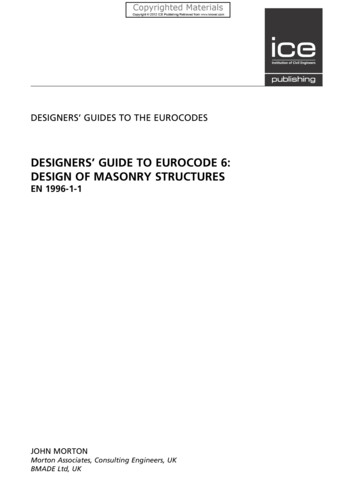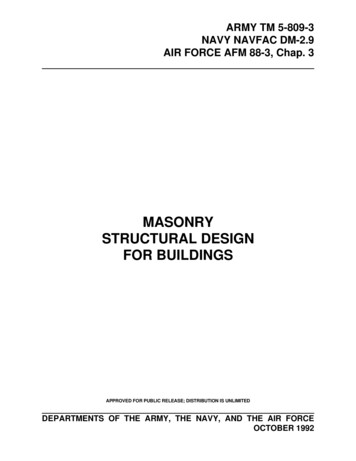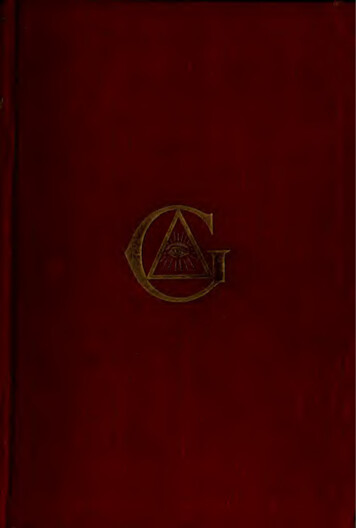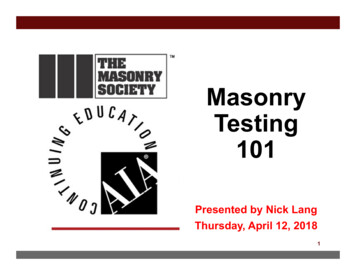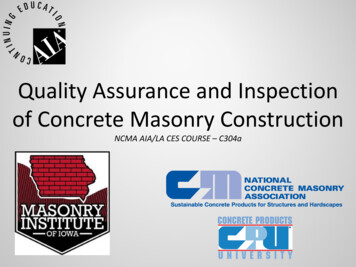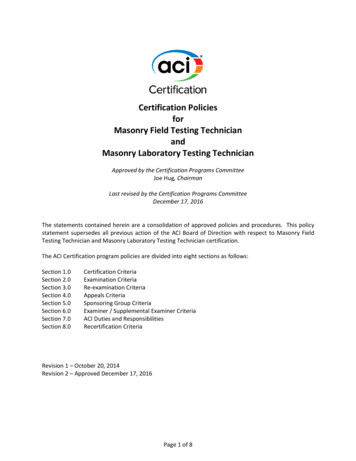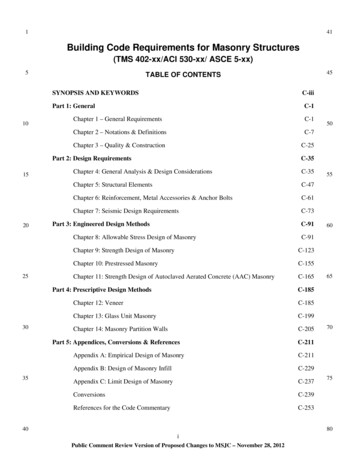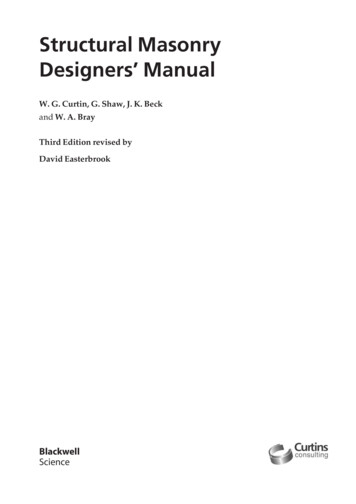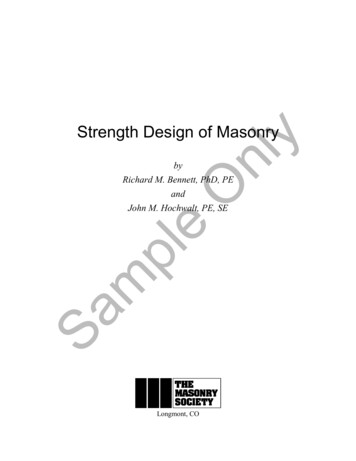
Transcription
nlyStrength Design of MasonrybyORichard M. Bennett, PhD, PEandSampleJohn M. Hochwalt, PE, SELongmont, CO
Strength Design of Masonry, by Richard M. Bennett and John M. HochwaltyPublished by The Masonry Society105 South Sunset Street, Suite QLongmont, Colorado, 80501-6172Phone: 303-939-9700Fax: 303-541-9215E-Mail: info@masonrysociety.orgWebsite: www.masonrysociety.orgnlCopyright 2020, The Masonry Society.eFront Cover Image: Phillip J. SamblanetBack Cover Image: Courtesy of Interstate BrickOAll rights reserved including rights of reproduction and use in any form or by any means, includingthe making of copies by any photo process, or by any electronic or mechanical device, printed,written or oral, or recording for sound or visual reproduction or for any use in any knowledgeretrieval system or device, unless permission in writing is obtained from The Masonry Society.plDISCLAIM OF LIABILITY FOR USEmThis publication was produced through TMS’s Independent Author Publication Program. Theopinions and statements presented herein are solely those of the author. The Masonry Society isnot responsible for the statements or opinions of the author, nor for any errors or omissions thistext may contain. The Masonry Society disclaims any and all responsibility for the application ofthe information.SaThis publication was prepared by TMS Staff and the authors who expressly disclaim any and allwarranties, either expressed or implied, with respect to those materials, or their fitness for anyparticular purpose. Neither the authors nor The Masonry Society assume any liability for direct,indirect, incidental, consequential, special, or exemplary damages, regardless of either or bothhaving been advised of the possibility of such damages, occurring from use of or the results of theuse of, this information in terms of correctness, accuracy, reliability, or otherwise. Informationpresented herein is not intended or represented to be suitable for direct use in design or constructionof masonry or any other material without additional engineering and architectural evaluation. Theuser relies on this information at his or her own risk.ISBN: 978-1-929081-63-9TMS Order No. TMS-1420-20
ABOUT THE AUTHORSDr. Richard Bennett is a Professor at the University of Tennessee and Mr. John Hochwalt isDirector of Engineering at KPFF Engineers. Both actively serve on TMS 402/602 which containsrequirements for strength design of masonry.yDr. Bennett served as the Chair of the 2016 TMS 402/602 Committee, leading the Committee forthat cycle, but also as a Chair of subcommittees and tasks groups for several cycles. He currentlyserves as the 2nd Vice Chair of the 2022 Committee. He has taught extensively and presented onStrength Design and many other topics for The Masonry Society and other groups, sharing insightsand findings from his research and trial designs. For his tremendous efforts in leading theCommittee, he received TMS’s President’s Award and was made a Fellow of the Society.nlMr. Hochwalt has also served actively on TMS 402/602 and currently Chairs its Seismic and LimitDesign Subcommittee. He was instrumental in the drafting of the Limit Design provisions inAppendix C of TMS 402 and has taught on this topic and many others, offering practicalobservations from his work as a Structural Engineer.ACKNOWLEDGEMENTSOBoth authors serve as authors of TMS’s Masonry Designers’ Guide.pleThe Masonry Society (TMS) sincerely thanks the authors for developing this excellent guide, whichwill assist those new to masonry in understanding the fundamental concepts of strength designwhile helping those more experienced perform designs more efficiently. The concept of this guidewas encouraged within the Society for many years, and upon suggesting it directly to the authors,they graciously volunteered to develop it and have spent countless hours in drafting, writing,editing, revising, and finalizing. Throughout the guide they have offered valuable insight,especially with their “Good Structural Design” Tips (GSD’s) that should be popular and helpful.Peter M. Babaian, Simpson, Gumpertz & Heger Inc. - TAC Chair and Review LeaderNoah F. Buchanan, TMS Project engineerCharles B. Clark, Brick Industry AssociationRick Crooks, Mutual MaterialsManuel A. Diaz - University of Texas at San AntonioEce Erdogmus, University of Nebraska–LincolnGary Porter, Masonry Advisory CouncilBora Pulatsu, University of Nebraska-LincolnPhillip J. Samblanet, TMS Executive DirectorL. Susan Scheurer, TMS Office ManagerPaul G. Scott, Caruso Turley Scott, Inc.Jason J. Thompson, National Concrete Masonry AssociationDiane B. Throop, Diane Throop PE, LLCScott W. Walkowicz, Walkowicz Consulting Engineers, LLC’Sa mTMS and the authors also thank members of the TMS Technical Activities Committee, as well asexternal reviewers, for their diligence in reviewing drafts of this publication and offeringconstructive comments for the author’s consideration. Their suggestions improved this guide.Reviewers included:
Strength Design of Masonry – Table of ContentsChapter 1 IntroductionScope . 1-11.2Benefits of Strength Design . 1-21.3Good Structural Design (GSD) Tips . 1-21.4Other Resources . 1-21.5Reference Standards .1-31.6Abbreviations. 1-41.7Notation . 1-41.8Definitions. 1-7OChapter 2 Introduction to Structural Masonrynly1.1Masonry units . 2-12.1.1 Concrete Masonry Units . 2-22.1.2 Clay or Shale Masonry Units . 2-32.2Mortar . 2-42.2.1 Mortar Types . 2-52.2.2 Mortar Cementitious Materials . 2-52.2.3 Proportion vs. Property Specification . 2-62.3Grout . 2-72.3.1 Conventional Masonry Grout . 2-72.3.2 Self-Consolidating Grout . 2-82.4Reinforcement . 2-82.4.1 Joint Reinforcement. 2-82.4.2 Reinforcing Bars for Masonry . 2-92.5Masonry Assemblage Material Properties . 2-102.5.1 Masonry Compressive Strength . 2-102.5.2 Modulus of Rupture . 2-122.5.3 Elastic & Shear Moduli of Masonry . 2-132.6Masonry Assemblage Construction. 2-142.6.1 Bond Pattern. 2-142.6.2 Partial vs. Full Grouting . 2-142.6.3 Section Properties . 2-152.7Selection of Unit Type .2-162.7.1 Unit Type in Examples . 2-162.8References . 2-17Sample2.1
Chapter 3 Masonry Structural Systems and ComponentsMasonry in Buildings . 3-13.1.1 Structural Functions of Masonry . 3-13.1.2 Architectural Functions of Masonry . 3-13.2Masonry in Landscapes . 3-13.3Masonry Members and Reinforcing Requirements . 3-23.3.1 Beams .3-33.3.2 Columns . 3-43.3.3 Pilasters . 3-43.3.4 Walls . 3-43.3.4.1 Non-Participating Walls . 3-63.3.4.2 Participating (Shear) Walls . 3-73.3.4.3 Perforated Walls . 3-103.3.4.4 Flanged Walls . 3-10nly3.1Chapter 4 General DesignStrength Design. 4-14.1.1 History . 4-14.1.2 Design Philosophy . 4-14.1.3 Strength Design Load Combinations . 4-24.2Serviceability . 4-44.2.1 Beams .4-44.2.2 Walls under Out-of-Plane Loads . 4-44.3Design Methodology. 4-44.3.1 Design Process – Buildings . 4-44.3.1.1 Global Lateral Behavior . 4-54.3.1.2 Volume Change Behavior (Joints) . 4-54.3.1.3 Examples . 4-64.3.2 Design Process – Landscape . 4-164.4References . 4-18mpleO4.1SaChapter 5 Strength Design of Unreinforced Masonry5.1General. 5-15.2Design Examples: Unreinforced Masonry . 5-35.2.1 Partition Walls Under Seismic Loads . 5-55.2.2 Horizontal Spanning Unreinforced Masonry . 5-85.3References . 5-13
Chapter 6 Strength Design of Reinforced MasonryGeneral. 6-16.1.1 Design Assumptions . 6-16.1.2 Nominal and Design Strength. 6-16.2Actions. 6-36.2.1 Flexure. 6-36.2.1.1 Flexural Design . 6-56.2.2 Axial .
Both authors serve as authors of TMS’s Masonry Designers’ Guide. ACKNOWLEDGEMENTS The Masonry Society (TMS) sincerely thanks the au thors for developing this excellent guide, which will assist those new to masonry in understanding the fundamental concepts of strength design while helping those more experienced perform designs more efficiently. The concept of this guide was encouraged .
